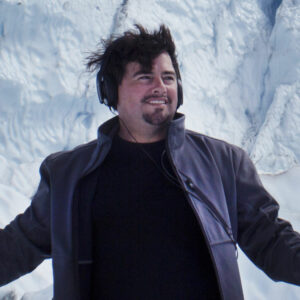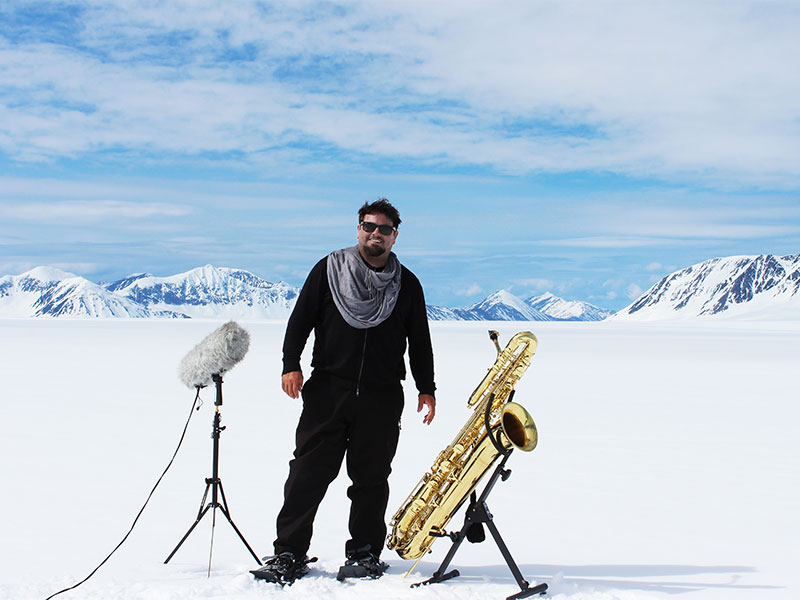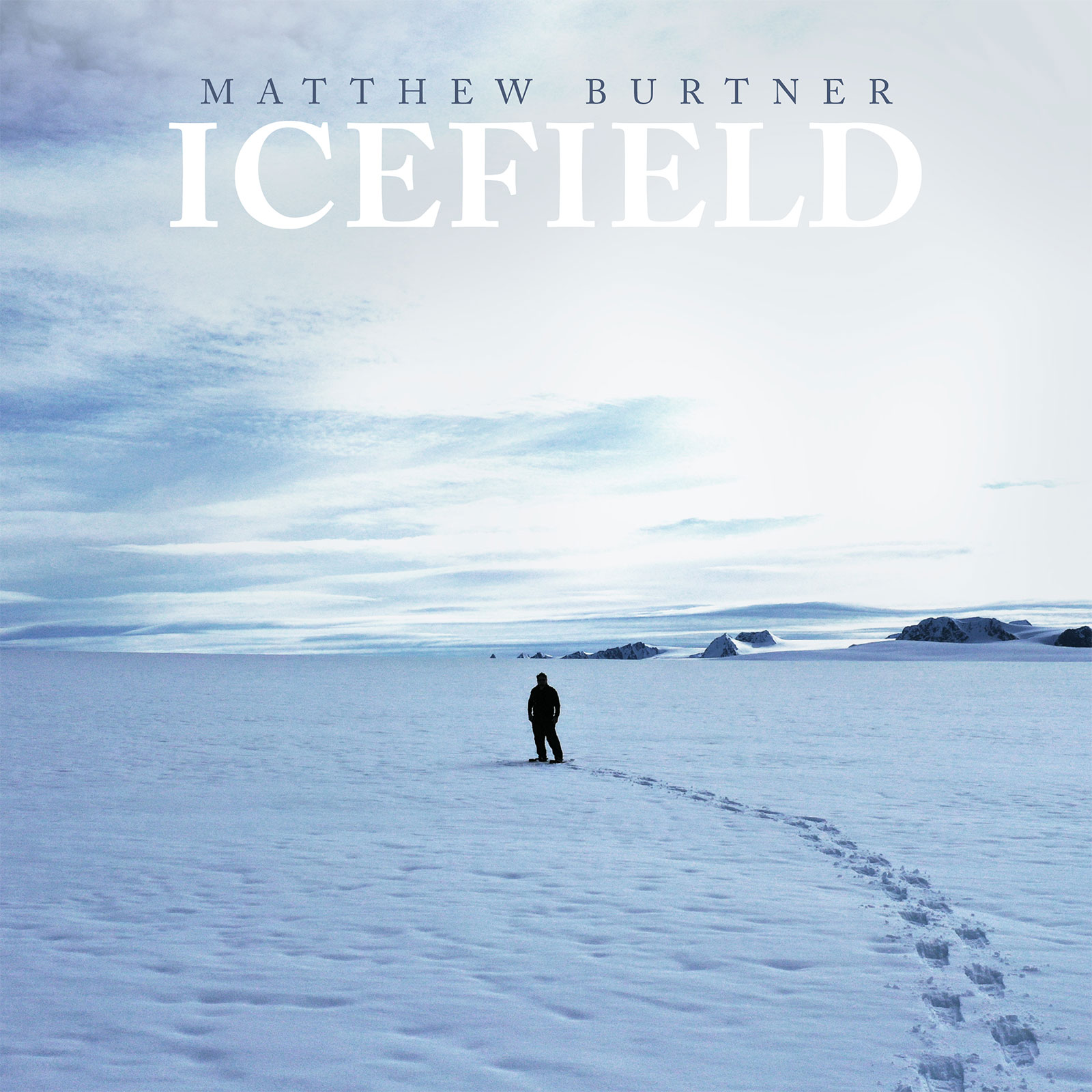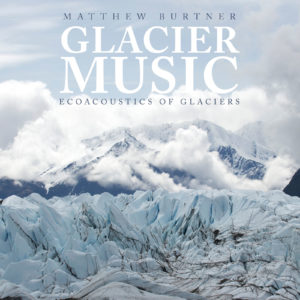Icefield
Matthew Burtner composer
If glaciers could speak, what would they tell us? On ICEFIELD, veteran composer Matthew Burtner answers that very question with an eclectic series of works that explore the intersection between the environment and controlled sound. Combining specialized field recordings of glaciers and Arctic storms, electroacoustics, and traditional instruments, Burtner creates surreal soundscapes that blur the line between audio and physical experience—from the opera Auksalaq to the audio synthesization of data on Sonification of an Arctic Lagoon, each piece on the album channels the whip-crack chill of the air, the blinding snow, and the awe-inspiring sight of glacial fields breaking apart and bringing sea levels higher and higher.
Listen
Stream/Buy
Choose your platform
Track Listing & Credits
| # | Title | Composer | Performer | |
|---|---|---|---|---|
| 01 | You Sink Into the Singing Snow | Matthew Burtner | EcoSono Ensemble | Lisa Edwards-Burrs, voice; Kevin Davis, cello; Kelly Sulick, flute; John Mayhood, piano; Naima Burrs, violin; I-Jen Fang, percussion; Glen Whitehead, trumpet | 6:58 |
| 02 | Icefield | Matthew Burtner | Matthew Burtner, saxophone & snow | 11:42 |
| 03 | Vaporous Clouds Condense | Matthew Burtner | EcoSono Ensemble | Lisa Edwards-Burrs, voice; Kevin Davis, cello; Kelly Sulick, flute; John Mayhood, piano; Naima Burrs, violin; I-Jen Fang, percussion | 2:53 |
| 04 | Sonification of an Arctic Lagoon | Matthew Burtner | BLE LTER | Ken Dunton, science; Craig Connolly, science; Christina Bonsell, science; Nathan McTigue, science | 3:51 |
| 05 | We are as One Plane | Matthew Burtner | EcoSono Ensemble | Lisa Edwards-Burrs, voice; Kevin Davis, cello; Kelly Sulick, flute; John Mayhood, piano; Naima Burrs, violin; I-Jen Fang, percussion | 6:02 |
| 06 | Threnody (Sikuigvik) | Matthew Burtner | A4E Ensemble | Kasia Sokol-Borup, violin; Hasse Borup, violin; Julie Edwards, viola; Viktor Uzur, cello; Jens Tenbroek, bass; Maddy Tarantelli, horn; Katie Porter, clarinets; Christina Castellanos, flute | 8:34 |
| 07 | Aialik Iceberg Sound Cast with Binaural Beats | Matthew Burtner | Matthew Burtner, multichannel iceberg field recording & computer-generated sound | 3:28 |
| 08 | Oil Drum | Matthew Burtner | Colin Malloy, percussion | 7:35 |
| 09 | Iceprints | Matthew Burtner | Chrysi Nanou, piano | 21:08 |
We are as One Plane (2012)
Session Recording Engineer Travis Thatcher
Vaporous Clouds Condense (2012)
Session Recording Engineer Travis Thatcher
You Sink Into the Singing Snow (2012)
Session Recording Engineer Travis Thatcher
Threnody (Sikuigvik) (2018)
Session Recording Engineer Ashkan Tabatabaie
Oil Drum (2020)
Session Recording Engineer Sean Kiley
Iceprints (2010)
Session Recording Engineer Rice Ross
RPI HASS Media Studio
Science data by Hajo Eicken / UAF Geophysical Institute and International Arctic Research Center (IARC)
The album features performances of Burtner’s work by EcoSono Ensemble, A4E Ensemble, Chrysi Nanou (piano) and Colin Malloy (percussion). The music also features data recorded by the Beaufort Lagoons Ecosystem (BLE) Long Term Ecological Research scientists in the Arctic.
Executive Producer Bob Lord
Executive A&R Sam Renshaw
A&R Director Brandon MacNeil
A&R Quinton Blue
VP of Production Jan Košulič
Audio Director Lucas Paquette
Mastering Melanie Montgomery
VP, Design & Marketing Brett Picknell
Art Director Ryan Harrison
Design Edward A. Fleming, Morgan Hauber
Publicity Patrick Niland, Aidan Curran
Content Manager Sara Warner
Artist Information

Matthew Burtner
Matthew Burtner is an Alaskan-born composer, sound artist, and eco-acoustician whose work explores embodiment, ecology, polytemporality, and noise. His music comfortably crosses boundaries between environmental science and art, philosophy and acoustics, technology and body, and he is a leading practitioner of climate change music and ecoacoustic sound art. As a composer, Burtner seeks out contexts where critical issues of human/nature interaction are addressed, whether in musical contexts, other forms of media, scientific conferences, or political conventions. His music has been performed in concerts around the world and featured by organizations such as NASA, PBS NewsHour, the American Geophysical Union (AGU), the BBC, the U.S. State Department under President Obama, and National Geographic.
EcoSono
EcoSono is a non-profit organization pursuing commonalities between innovative musical creation and ecological sustainability since 2009. Through education, engagement, and artistic production, EcoSono defined a unique methodology for environmentalism and the arts. National Geographic called EcoSono’s production Auksalaq “a significant cultural event that marries science as the brain, art as the heart and culture as the soul in our search for awareness and sustainability.” EcoSono has organized concerts from Alaska to Namibia to Australia and venues in between. The EcoSono Ensemble combines chamber music performance, improvisation, new technologies, and ecoacoustics. The group gave its debut performance at the 2012 premiere of Auksalaq. Since then, EcoSono Ensemble has performed in Alaska, Washington DC, Colorado, Texas, Virginia, Canada, California, and throughout Australia and Tasmania.
Artists for the Environment (A4E)
Artists for the Environment (A4E) is a project organized through the University of Utah in partnership with a number of academic and environmental organizations to promote environmental activism through music. The project is directed by Hasse Borup and Elisabet Curbelo. The ensemble includes Kasia Sokol-Borup, violin; Hasse Borup, violin; Julie Edwards, viola; Viktor Uzur, cello; Jens Tenbroek, bass; Maddy Tarantelli, horn; Katie Porter, clarinets; and Christina Castellanos, flute.
Colin Malloy
Colin Malloy is an award-winning percussionist specializing in contemporary solo and chamber percussion, the steel pan, and music technology. Malloy has performed at the Percussive Arts Society International Convention (PASIC), the Bang on a Can Summer Marathon, and at the Trinidad and New York Panoramas. He was a founding member of Left Edge Percussion, the chamber percussion group in residence at Southern Oregon University under the direction of Terry Longshore. He is currently pursuing an interdisciplinary Ph.D. in music and computer science at University of Victoria in British Columbia focused on steelpan. He holds a B.A. in Pure Mathematics from Whitman College, a B.S. in Music Education from Oregon State University, an M.M. in Percussion Performance from Southern Oregon University, and a M.Mus. in Music Technology from University of Victoria.
Chrysi Nanou
Pianist Chrysi Nanou combines a career as a performer, curator, lecturer, and devoted teacher of all ages. Born in Greece, Nanou’s personal and professional aesthetics were formed in Paris and further shaped in the United States with her studies at the Ecole Normale de Musique de Paris / Alfred Cortot, The Peabody Institute of The Johns Hopkins University, and at Stanford University’s Center for Computer Research in Music and Acoustics (CCRMA). Her repertoire is particularly diverse, ranging from core classical music to 21st century and in a wide variety of genres with an emphasis on electroacoustic contemporary music. Appearing as a concert pianist in over 30 countries, she has premiered many compositions by young and eminent composers. Nanou has served as the Artistic Coordinator of CCRMA (Stanford University) and sits on the board of the International Computer Music Association (ICMA). She is currently Visiting Faculty at RPI and a Ph.D. Candidate at Cambridge University at the Center for Music and Science.
Notes

Icefield_Notes-1
Matthew Burtner Recording ICEFIELD


